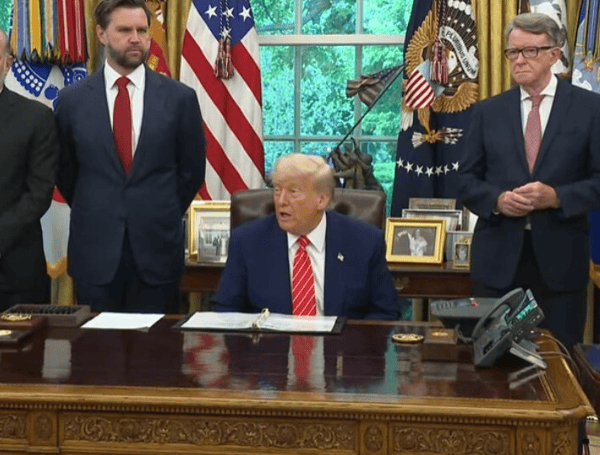In a move hailed as historic, the United States and the United Kingdom today announced a comprehensive trade agreement, marking the 80th anniversary of Victory Day.
The deal, unveiled in a joint statement by U.S. President Donald J. Trump and UK Prime Minister Keir Starmer, promises to reshape the economic landscape between the two long-standing allies, offering American businesses unprecedented access to UK markets while bolstering U.S. national security interests.
President Trump lauded the agreement as “a great deal for America,” emphasizing the significant increase in market access for American exports, particularly in the agricultural sector.
READ: Texas Sen. Cornyn Intros Bill To Codify Death Penalty For Illegal Immigrant Murderers
“The deal includes billions of dollars of increased market access for American exports, especially in agriculture, dramatically increasing access for American beef, ethanol, and virtually all of the products produced by our great farmers,” stated President Trump.
He further noted the UK’s commitment to reducing or eliminating numerous non-tariff barriers that had previously disadvantaged American products.
Prime Minister Starmer echoed this sentiment, stating, “This is going to boost trade between and across our countries. It’s going to not only protect jobs, but create jobs, opening market access.”
The fact sheet released by the White House details key aspects of the trade deal, highlighting an anticipated $5 billion opportunity for new exports for U.S. farmers, ranchers, and producers.
This includes a significant boost for ethanol exports, projected to exceed $700 million, and $250 million in other agricultural products like beef.
Beyond agriculture, the agreement encompasses several crucial areas:
- Enhanced Market Access: The deal commits both nations to ongoing collaboration aimed at further improving industrial and agricultural market access.
- Fair Competition: Loopholes in the UK’s procurement market will be closed, enhancing the competitiveness of U.S. firms.
- Streamlined Customs: U.S. exporters will benefit from more efficient customs procedures.
- High Standards: The agreement establishes robust commitments in intellectual property, labor, and environmental protection.
- Aerospace Security: Preferential access to high-quality UK aerospace components will maximize the competitiveness and secure the supply chain of U.S. aerospace manufacturers.
- Pharmaceutical Security: The deal aims to create a more secure supply chain for essential pharmaceutical products.
The agreement also addresses the reciprocal tariff rate of 10%, initially announced on Liberation Day. Notably, an alternative arrangement has been reached regarding the U.S. Section 232 tariffs on UK autos. Under the new terms, the first 100,000 vehicles imported annually from UK car manufacturers will be subject to the 10% reciprocal rate, with any additional vehicles facing the existing 25% rate.
READ: Trump Announces ‘Historic’ US-UK Trade Deal On Victory Day Anniversary, Stocks Climb
Furthermore, the United States has acknowledged the UK’s economic security measures designed to combat global steel excess capacity and will negotiate an alternative arrangement to the Section 232 tariffs on steel and aluminum, effectively creating a new trading union for these materials.
President Trump emphasized that this U.S.-UK trade deal marks the beginning of “a golden age of new opportunity for U.S. exporters” and will level the playing field for American producers. He also expressed hope that this agreement would set a precedent for other trading partners to pursue reciprocal trade with the United States.
The announcement follows a recent phone call between President Trump and Prime Minister Starmer on April 18th, where bilateral trade relations were a key topic of discussion. In 2024, total goods trade between the U.S. and the UK was estimated at $148 billion. The fact sheet highlighted existing disparities, noting the UK’s average applied agricultural tariff of 9.2% compared to the U.S.’s prior average of 5%, and cited instances of UK tariffs exceeding 125% on certain meat, poultry, and dairy products, alongside non-science-based standards hindering U.S. exports.
READ: US Sanctions Third China “Teapot” Refinery, Maritime Network Over Iranian Oil Sales
The Trump administration framed this deal as a continuation of its “America First” trade policy, aimed at reversing what it considers unfair trade practices that have historically disadvantaged American workers and businesses. By enhancing market access and lowering trade barriers with a key ally, the administration believes this agreement represents a significant step towards promoting reciprocal trade and bolstering American economic prosperity.
Please make a small donation to the Tampa Free Press to help sustain independent journalism. Your contribution enables us to continue delivering high-quality, local, and national news coverage.
Connect with us: Follow the Tampa Free Press on Facebook and Twitter for breaking news and updates.
Sign up: Subscribe to our free newsletter for a curated selection of top stories delivered straight to your inbox.
